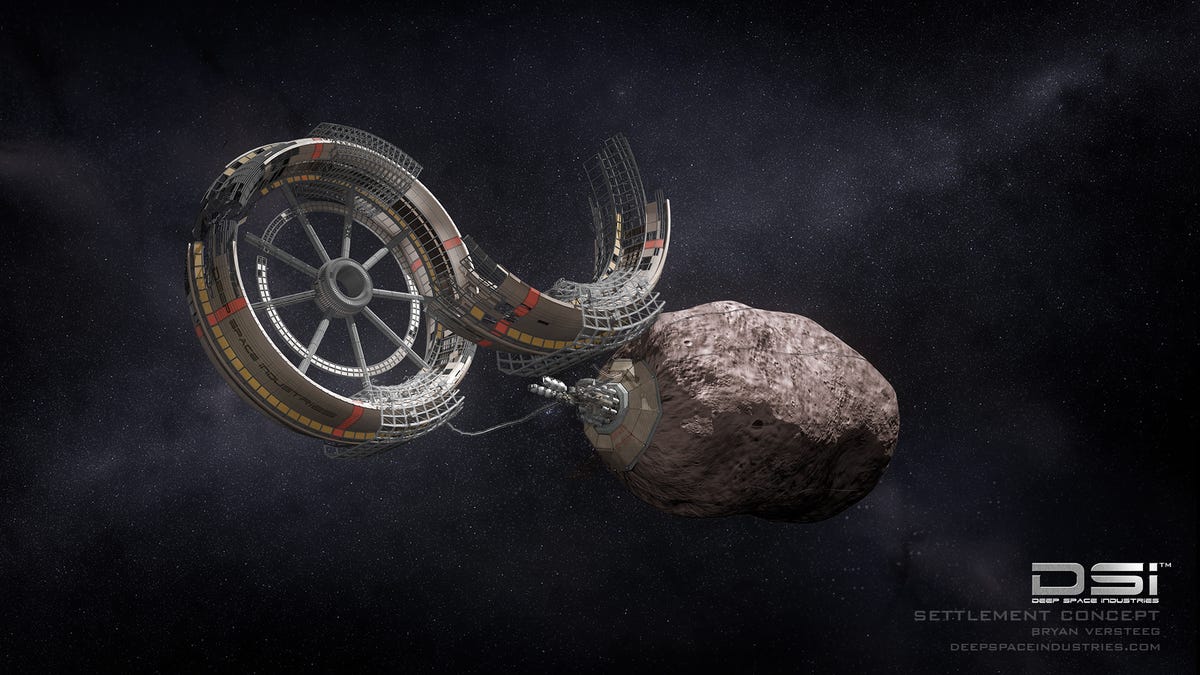Mining asteroids to 3D-print space stations: Beyond pie in the sky?
New startup Deep Space Industries has big plans for those big floating space rocks in the next 10 years. Crave's Eric Mack searches for a new superlative to describe the effort.

I'm in search of a new phrase to replace "pie in the sky" to describe the latest ambitious space mining startup. On its face, the notion of 3D printers on asteroids seems more ridiculous to me than a simple lemon meringue in the clouds, and yet that is exactly what the just-launched venture Deep Space Industries (DSI) proposes to do.
Less than a year after Planetary Resources announced its own plans to mine asteroids in space, DSI is upping the ante with its own vision for zero-gravity resource extraction that goes one step further to include actually producing things in space using the company's "MicroGravity Foundry... a patent-pending breakthrough in 3D printers able to output complex metal components using a simple process with few moving parts."
The idea is that it should be much cheaper and more efficient to build what's needed to further space exploration using resources extracted from asteroids than shuttling materials from Earth. Imagine sending a robot into a mountain with some mining tools and a 3D printer. The robot mines material to feed into the 3D printer, which prints up more robots and supplies to build a smelter at the mouth of the mine, which is then used to build even bigger things. You get the idea.
Take that whole sci-fi premise and rocket it into space, and that seems to be about what DSI is hoping to accomplish. Or, if you prefer CEO David Gump's ironically more down-to-earth comparison:
More than 900 new asteroids that pass near Earth are discovered every year. They can be like the Iron Range of Minnesota was for the Detroit car industry last century -- a key resource located near where it was needed. In this case, metals and fuel from asteroids can expand the in-space industries of this century. That is our strategy.
According to the company's launch press release, it hopes to be far enough along in a decade's time to "construct large communications platforms to replace communications satellites, and later solar power stations to beam carbon-free energy to consumers on Earth. As DSI refines asteroids for in-space markets, it also will harvest platinum group metals for terrestrial uses, such as pollution control devices."
All that in a decade, huh? See what I mean? "Pie in the sky" just doesn't cover it. It's more like "Pinkberry in the asteroid belt" (help me out here; suggest better metaphors in the comments). Much like the epic merging of Willy Wonka and Jetsons concepts that is this proposed space elevator, I really, really want to see DSI succeed, but starting construction on the first asteroid-mounted satellite in just 10 years?
You know, SpaceX has been around for about that long, and it's just now managed to dock with the far more welcoming International Space Station. And that's with the benefit of having Elon Musk, a real-life Tony Stark who somehow seems to turn his insane billionaire delusions of grandeur into reality, at the helm.
So, let's take it down a notch, DSI, before we start talking about the long-term "extra-orbital baked Alaska" dreams (damn! still needs work). Let's talk first steps.
DSI says it plans to get started by launching small reconnaissance craft dubbed "FireFly" -- pour one out for all our dead homies caught up at the and of a Reaver spear, ya'll. FireFlies will act as kamikaze scouts with one-way tickets to search for asteroids ripe for the picking... or mining.
Once the FireFlies identify target space rocks, the next phase is to send larger "DragonFly" craft that will take two to four years to bring some samples of up to 150 pounds back to Earth.
If everything goes well up to this point, it could be time to send the MicroGravity Foundries up to start turning asteroids into metal parts and fuel for other space missions and eventually to start building new satellites and solar power stations.
"We will only be visitors in space until we learn how to live off the land there," said Deep Space Chairman Rick Tumlinson. "This is the Deep Space mission -- to find, harvest, and process the resources of space to help save our civilization and support the expansion of humanity beyond the Earth -- and doing so in a step-by-step manner that leverages off our space legacy to create an amazing and hopeful future for humanity. We are squarely focused on giving new generations the opportunity to change not only this world, but all the worlds of tomorrow. Sounds like fun, doesn't it?"
Yes, of course it sounds fun and awesome and game-changing and all that stuff. But until the first successful mission, it also sounds about as likely to happen in the next decade as building a Baskin-Robbins on Jupiter's Big Red Spot. (Nailed it!)

